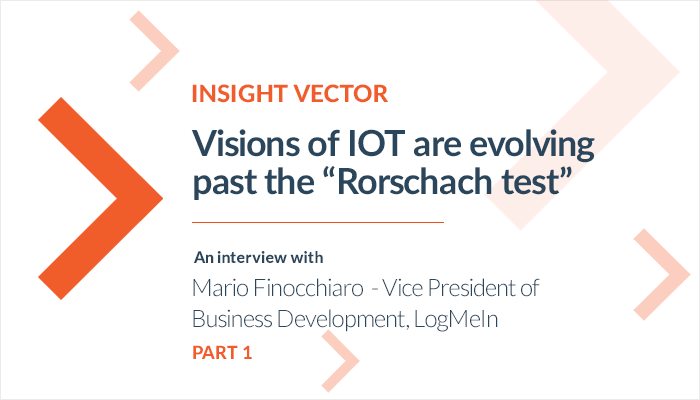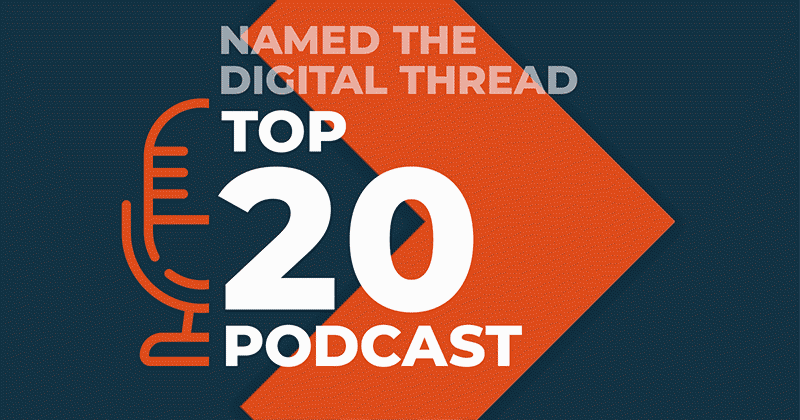Insight Vector: Visions of IoT are Evolving Past the “Rorschach test,” An Interview with Mario Finocchiaro – Part 1
Ed Maguire

 Innovation and market perspectives from leading IOT innovators
Innovation and market perspectives from leading IOT innovators
In this first part of our interview with Mario Finocchiaro, he talks about how the term "IoT" feels like a Rorschach ink blot – technology providers have naturally viewed IoT through the lens of their own expertise whether it be hardware, networking or software. In his view, the maturing of software platforms has enabled the market to evolve past the DIY phase – and the connected home industry which disappointed aggressive expectations early on may be poised to take off.
|
|
Mario Finocchiaro |
Mario Finocchiaro is a founding member of Xively's leadership team since its inception in 2013 and serves as Vice President of Business Development for IoT, Customer Engagement, and Support at LogMeIn. He is an experienced executive and entrepreneurial leader with a track record of driving global customer success in the IoT, SaaS, enterprise software, telecommunications, computer networking, semiconductor, and connected home industries while holding senior-level business development, sales, marketing, and management positions in the United States and Europe.
What does IOT mean to you?
The term “IoT” has felt like a Rorschach inkblot test - it touches so many parts of business and tech that it can mean almost anything to anyone! Some view IoT as smart, connected hardware that instruments and controls the physical world. Others view it as data and intelligence that for proactive insights, efficiency and productivity. Still others see it as cool apps and new user experiences for mundane, everyday tasks. And yet others see it as the possibility to create new business models. All that possibility of what “could” be done has made for some terrific use cases, but it has also presented some big challenges for the industry. Despite lots of truly great products being out there, there still hasn’t been an “iPhone moment”; that single killer device or use case that’s revolutionized the market. Getting to that moment, I think, is about bringing these pieces together in simple, intuitive ways where “IoT technology” becomes invisible and we’re talking about making things better for customers.
What about your experience informs your perspective of IOT?
For me it started at Axis Communications in the mid-1990’s where we were talking about “access to everything” – when all products would be connected to networks and available to everyone all of the time. We were bringing the concept to life with our “ThinServer” technology that was built on our RISC-based ASIC, multi protocol networking stack, and embedded web server. But the real breakthrough was in 1996 when we launched the first IP-addressable cameras that you could control and view anywhere from a web browser. It changed the game for us, and for the industry. Today you would call these IoT products.
From there, I had the opportunity to work with some incredibly talented people at Aware, Inc. where we provided highly specialized broadband technology to some of the world’s leading semiconductor companies, and then we built some of the same core technology into enterprise software platforms that telecom service providers used for managing the health of their broadband access networks and millions of subscribers. This led to some really interesting work in home networking technologies and industry standards. Taken together, I think that these different vantage points really helped shape a holistic view of what it takes for connected businesses to succeed – and that’s what brought me to LogMeIn and Xively.
What’s different about the market since you launched Xively?
When we launched Xively, the industry was flying full speed up the IoT Hype cycle. Everything was about the art of the possible. Our partners like ARM and Salesforce.com, and plenty of other companies were talking about the imminent revolution of the IoT. The truth was that the plummeting costs and skyrocketing capabilities of cloud computing, mobile devices, chip sets, sensors, and networks were setting the stage to bring IoT to the mainstream. We called it “the power of the small, and the revolution of the cheap” and spent a lot of time educating the marketplace on the all the essential steps to building world-class IoT products. Our early customers became the real heroes who brought the innovation to life.
Then when the business potential of IoT started becoming clearer, the market went into a DIY phase. Companies began using combinations of standard IT tools, protocols, IaaS platforms, open source technologies, and marker-type hardware to build early prototypes and products. But before too long, it became apparent for most companies that building secure, commercial-grade, and massively scalable platforms wasn’t a skill set that they had, or wanted to have. That’s when the value proposition flipped and companies turned to proven platforms like Xively so that they could focus where it mattered - on their business innovation and their customers.
What are some notable successes you are seeing?
IoT is still in its early days, but we are seeing a lot of great successes across product industries – especially smart home and energy. Lutron, for example, is one of our customers that has a great connected lighting and shade system that can be deployed in minutes and easily controlled through an app. Looking over to Europe, Sowee has a highly innovative in-home energy monitoring and management device that gives consumers the ability to manage to their desired energy budget, or to a desired comfort level. Additionally, ecosystems like Amazon Echo, Google Home, and Apple Home Kit are beginning to drive the connected home adoption. As an industry, I think that we overestimated what the adoption of the connected home would have been in the past few years, but given the popularity of ecosystems like these, we might be underestimating it in the next few.
Stay tuned for the next part of Mario's interview, where we discuss opportunities in the market and the future of connected products.




